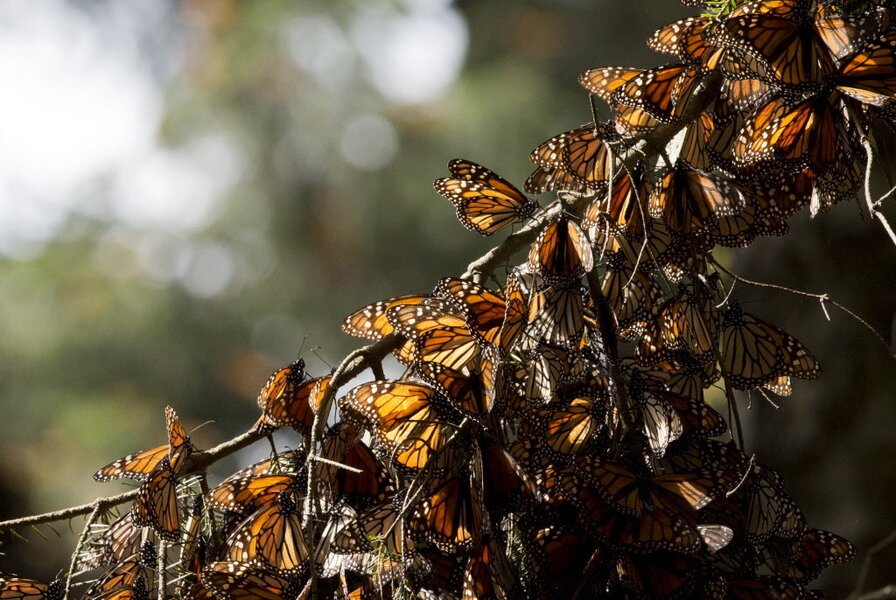In Mexico, hopes of uptick in dwindling Monarch butterfly migration
| Macheros, Mexico
The first sign of the butterflies is a detached wing laying in an open field and sighted after an hour-long horse ride up a steep, rocky mountain path on a crisp December afternoon.
Rogelio, a local guide at the Cerro Pelon Monarch Butterfly Sanctuary, a state park, picks up the delicate black, white, and orange amulet and holds it above his head. “We’re getting close,” he says.
There’s another hour of travel – more horse-back riding on dense forest paths, culminating in a winding hike amid wild mint plants and giant pink thistles.
But the trek is short compared to the more than 3,000-mile journey south that brings millions of North American Monarch butterflies to the high-altitude tropical forests of Mexico’s Sierra Madre mountains.
The Mexican government and international conservation groups are hopeful that the winged population this year could cover nearly 10 acres in central Mexico, three-to-four times the size of 2014, when there were an estimated 35 million butterflies.
It’s seen as good news. For two decades the winter migrations have declined dramatically. In 1996 the butterflies covered about 44 acres here and in neighboring Michoacán state and they numbered nearly one billion.
Today renewed multi-national efforts to preserve the farthest migrating butterfly population in the world seem to be working. So do efforts to aid the Monarch's habitat after it was degraded due to farming, development, extreme changes in temperatures, and excessive and often illegal logging in North America.
The Monarch's “survival is important and symbolic,” says Juan Bezaury, the Mexico country representative for The Nature Conservancy. “It’s a species that needs all three North American nations cooperating to preserve this important natural phenomenon.”
'Confetti bursting'
Inside the reserve, the dotted creatures inspire awe as they cluster on tree branches in the thousands, perch on rocks and moss, rapidly fluttering their wings to stay warm.
The park rules are simple: don’t cross the thin, single-wire fence that earmarks butterfly territory, and keep your voice to a whisper.
The almost inaudible “wows” and “ohh – ahhs” of those that turned out to see the butterflies today add to the magic. Every so often the silence is punctuated by the sound of what guide Rogelio describes as “confetti bursting.” It is what happens when a branch-load of butterflies erupts into the air, rapidly flapping their wings as they find a new place to perch.
Eventually, as temperatures drop this winter and more butterflies arrive, the droves of Monarchs will move further down the mountain, populating an open field below.
Conservation remains a top priority and there’s been a push in the US and Canada for farmers and citizens to plant milkweed, a plant the butterflies rely on as a source of food and a place to lay their eggs.
In Mexico, programs have also been launched to prevent illegal farming, including cash transfers to communities that don’t cut down the pine and oyamel fir forests crucial for the Monarch’s winter survival.
But there’s still a lot of work to be done. Illegal logging in Mexico fell to almost zero three years ago, but is again on the rise, with a reported 24 acres clear-cut in the butterflies’ wintering grounds between April and August this year.
There’s also increased concern that global warming could play a detrimental role in conservation efforts, as high amounts of rain and cold are forecast this year.







